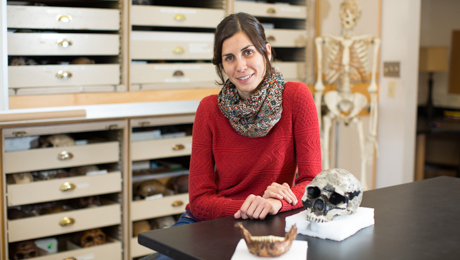By Danny Freedman
It’s a gap between teeth that will need much more than braces to fix: A new study of ancient teeth finds that none of the species suspected of being the ancestral link between modern humans and Neanderthals quite fits the bill.
The study, conducted by an international team of scholars that included a George Washington University researcher, was published online Monday in the Proceedings of the National Academy of Sciences. Among its findings, the study also suggests that the two species may have diverged hundreds of thousands of years earlier than previously thought.
“The last common ancestor of Neanderthals and modern humans may have been located in Africa around 1 million years ago,” said lead researcher Aida Gómez-Robles, a postdoctoral scientist at GW’s Center for the Advanced Study of Hominid Paleobiology. “If those fossils are found, they will be the ones that can give us a clearer answer to this problem.”
That may mean finding new species or simply better-preserved fossils. African populations dating back 1 million years—which were not included in the study due to the scarcity of dental fossils, Dr. Gómez-Robles said—are “the most promising source of candidates,” the researchers wrote.
The hardness and small size of teeth make them a well-preserved and very common line of evidence, Dr. Gómez-Robles said, offering a good representation of many early species in the human family tree.
The research team included scientists from Indiana University, Austria and Spain, where Dr. Gómez-Robles conducted the research as a graduate student.
Scientists think modern humans and Neanderthals evolved in Africa and Europe, respectively, once they separated from their common ancestor. Genetic studies vary on the timing of that separation, ranging from 300,000 to 850,000 years ago, the researchers wrote.
The team analyzed 1,200 teeth representing 13 types of ancient human, including species that have been proposed as that common ancestor, such as Homo heidelbergensis, Homo antecessor and Homo erectus. Using a dozen evolutionary scenarios the team loosely estimated the features of the common ancestor’s teeth and looked for a match.
The results, they wrote, were “striking.” The chances of any of those species being the shared ancestor are “at best, weak.”
Among the lot, the best fit was an African group known as Homo ergaster (considered by some to be simply an ancient form of Homo erectus), despite it having lived far outside the time period of 500,000 to 1 million years ago in which researchers expected to find a match.
The team also found that the European fossils all appeared more closely related to Neanderthals than to modern humans, leading them to suggest the two species separated earlier than suspected, around 1 million years ago.
Meanwhile the study itself, they wrote, also demonstrates the utility of this type of analysis, which Dr. Gómez-Robles said is common in the study of other species but rarely for human evolution.


